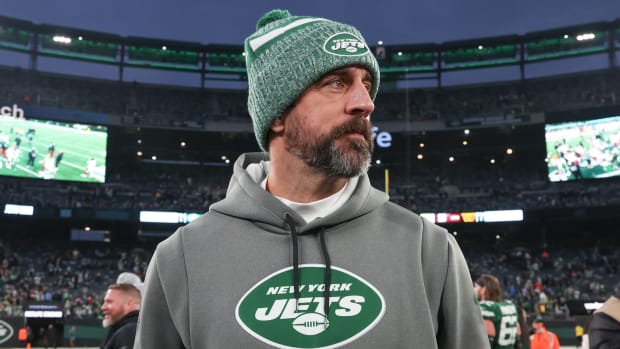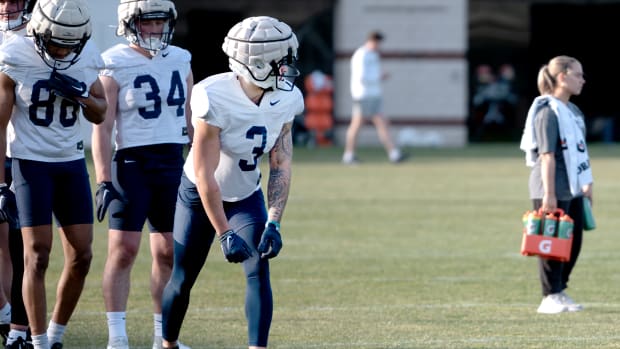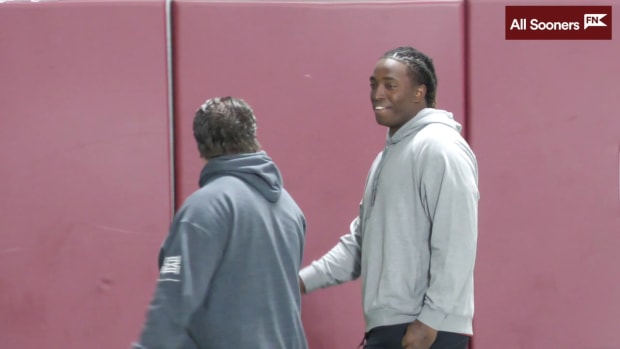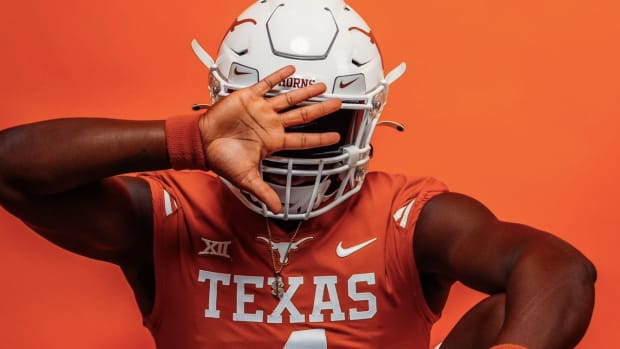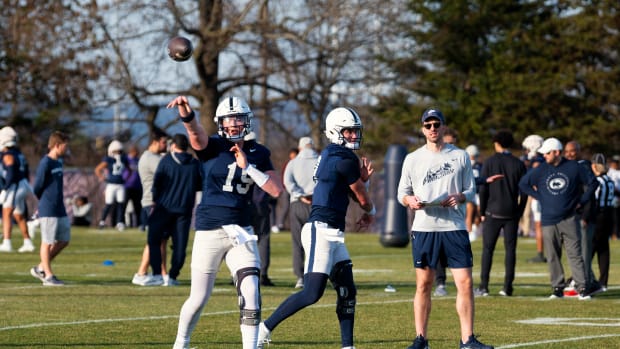Year 1 of NIL Brought Curveballs, Collectives and Chaos. Now What?
Take a walk on the red carpet at the College Football Hall of Fame in June 2022, and you’ll find it hosting an event that might have been unthinkable 12 months ago: the inaugural NIL Summit. The three-day event included an awards show that recognized athletes not just for their competitive exploits, but also for their marketability and commercial success in college sports’ new era.
On July 1, 2021, the economics changed forever when nearly half a million college athletes became eligible to make money off of their name, image and likeness (NIL) overnight. For better and for worse, college sports is a uniquely American institution, and it makes it difficult if not impossible to separate NIL from the myriad issues surrounding the NCAA. In fact, because the enterprise is so wide-ranging, the tentacles of NIL have interwoven and amplified things. While sources agree NIL is a positive in itself, the way it has played out has made the college athletics source who told Sports Illustrated on the eve of the initial rollout that “it’s going to be a clusterf----” look prescient.
NIL is not going away, and Sports Illustrated spoke to a cross section of people from athletes to lawyers to school administrators—and many in between—to get a sense of what it’s been like to live through this radically evolving market.
The more you dig into the landscape, the more apparent it becomes that there are, in effect, two worlds of name, image and likeness. There’s what was on display at the Hall of Fame in Atlanta: a celebration of the new era the way it was largely envisioned to operate. Then, there’s the rapidly expanding space that fueled, most notably, the recent spat between Jimbo Fisher and Nick Saban: booster-funded collectives that traffic in the recruiting inducement and pay-for-play space.

Ohio State football players were among those able to take early advantage of NIL rules with autograph signings. The school says its athletes have inked over 1,000 deals.
Barbara J. Perenic/The Columbus Dispatch/USA TODAY Network
The battle over collectives—and enforcement
Darren Heitner, a Florida-based lawyer, works with NIL in many different ways, including representing athletes, helping Florida lawmakers craft the state’s initial NIL law and working with the University of Florida’s collectives. Collectives, through their outspoken sponsors and big money amounts, have seized the headlines and by perception have come to define what NIL is to the public because football drives the bus in college sports.
Looking back, it’s easy to see how collectives operating as an over-the-table extension of the under-the-table recruiting inducement market that has always existed for college football and men’s basketball players would be a natural progression, but even Heitner admits he didn’t expect as much focus and attention on the collective side of NIL.
“If you are a school that doesn’t have a collective—which obviously isn’t [officially] associated and affiliated—but has a mission to directly promote and benefit a specific school, are you now behind the curve? And the answer is yes,” Heitner says. “And I don’t know if I necessarily would have expected that going into July 1.”
The path of least resistance was always to allow third parties to pay players, but when states and the NCAA cut the schools out of the equation to the extent that they did, a vacuum was created—and nature abhors a vacuum.
NIL has further exposed just how little control the NCAA currently exerts over college sports, or at least how much it wishes to exert. Why the governing body did not put something approaching strict guidelines in place before the NIL era began boils down to the fact that the organization is being sued left and right, reportedly spending just over $300 million in outside legal expenses going back the last seven years. In many ways, the current messiness with NIL is the NCAA reaping what has been sewn over a century of inaction; more specifically, a more recent failure to be proactive about where college sports was headed. The NCAA was content to fight to preserve its definition of amateurism instead.
The organization instituted an interim policy on the eve of NIL’s rollout that left schools on the hook to either navigate their state legislation or come up with their own institutional policies. The NCAA’s interim policy hasn’t been updated since being implemented on June 30, 2021. More than half the states in the union had NIL laws passed when the switch got flipped on July 1, but now many of the early adopters have buyer’s remorse.
Mississippi, Tennessee, Illinois and Louisiana have already amended theirs. The chief concern was that many of the laws, in one way or another, restricted how much athletic departments could get involved. South Carolina suspended its law in March, and Connecticut introduced new legislation updating its law. Each state had prohibitions on athletes using the school’s colors, marks or logos to do deals. Many state laws prohibit colleges from causing compensation to be provided to athletes.
When presenting his state’s amended bill on the statehouse floor, Louisiana representative John Stefanski was clear:
“If we want LSU or any other of our universities to be able to compete [in recruiting] with Texas A&M and with Alabama and see Nick Saban upset on a regular basis on the sideline, we have to be competitive,” he said.
Alabama has gone a step further, fully repealing its law in February largely because it was more restrictive than the NCAA’s scant NIL policies, which don’t actually prohibit schools from facilitating deals.
In the interim, the NCAA appealed to Congress for national legislation to bail it out. But Congress is not expected to offer up a solution anytime soon, those around college sports say, as different issues mount in the United States from gun control to inflation to the Supreme Court’s repeal of Roe v. Wade in a midterm election year. Florida, meanwhile, will have to wait until the next legislative session to amend its law as it missed the opportunity this spring.
Collectives are certainly not going away in the eternal off-the-field side competition with the direct effect on the on-field product.“It’s like a battle between them now because they can be involved not under the table,” says one SEC personnel staffer “They’re poking their chests out to each other. It’s millionaires trying to show other millionaires who has the biggest d---.”
Over 100 collectives now exist, with a high percentage of programs at the Power 5 level having one established or in development, with some Group of 5 schools getting in the mix as well. Schools communicate with them to varying degrees. Currently the loudest collectives have something in common: The football program has past success that’s a little too far in the past for their liking. Think Miami, Texas A&M, Tennessee, USC and Texas, to name a few. But not all collectives are playing the recruiting-inducement game.
In that way, NIL and its collective infrastructure have inflamed the constantly bubbling issue in college football: Should some or all FBS schools split off from the rest of college sports to make their own rules and, importantly, make more money? That debate is in addition to the shot in the arm the transfer portal one has gotten as NIL deals are used to entice player movement. If there is to be any regulation in the space, the likeliest avenue would be something to curtail collectives operating recruiting inducements.
But rather than any significant NIL crackdown, the NCAA kicked the can down the road in May, opting to instead just effectively restate the rules, reminding schools of what they have in place. Who wants enforcement? Some people from the collective side and the school side do, but with a purpose—not just to enforce a byzantine rulebook for the sake of doing so, but to also help establish guardrails and guidelines for the industry. The NCAA is at least initially looking into Miami’s collective activity, and whether the Hurricanes end up being a pelt on the wall remains to be seen. The push-pull of enforcement is a key factor that will define Year 2 of NIL and beyond.
“I have found it disappointing but understandable right now that the NCAA, as well as the coaches that you have seen taking their thoughts to Congress, have all approached this in terms of trying to delineate what should not be done and what cannot be done and what must be avoided. That generally points at recruiting,” says Adam Fleischer of Illinois’s Illini Guardians collective. “So while everybody is rushing to reach some consensus of what’s not allowed, there’s very little guidance as to what NIL can be and what it should be and what its potential is.”

Clapper, a Florida gymnast, created a gymnastics board game that she now sells online.
Brad McClenny/The Gainesville Sun/USA TODAY Network
The agent question
What will always redeem college sports as it slogs through one legislative crisis or another are the athletes, and NIL has solved the problem of simply allowing them the ability to be paid.
Beyond the money, there’s a very real on-the-job education component that can’t be replicated in a classroom. Duke cross-country runner Emily Cole has more than 160,000 followers on TikTok and 57,000 on Instagram. But with the notoriety comes other lessons beyond balancing school, workouts and content creation. She’s much more careful now about posting her location on her Instagram story in real time, cognizant about her personal security and asking permission of teammates who may be included in a photo she posts.
Cole’s older sister, Julia, is a country music artist who had been telling her for years to get into social media. Before NIL was even on her radar, Cole began working on her brand and was able to seize the moment in July 2021. At first she went through an online NIL marketplace to sign deals, which is the most straightforward way athletes get connected to brands. Marketplaces serve as a middle man connecting as many athletes to as many brands as have signed up to begin a conversation that will hopefully lead to a deal. Some marketplaces charge a small subscription price to either the businesses or the athletes, and marketplaces stake their reputation on vetting businesses themselves.
Others did it themselves, grabbing the bull by the horns and becoming entrepreneurial go-getters. Take Rayquan Smith, a track athlete at Norfolk State and a self-branded “King of NIL” who estimates that he’s signed more than 70 deals.
“Being at a small school, you’ve got to work a little harder because you don’t get the same opportunities that bigger schools get to show people that you can get deals from NIL at a small school,” Smith says.
Florida gymnast Leah Clapper had, in some ways, been training for the NIL era throughout high school, although she didn’t realize it. She’d always wanted to start her own business and that put her in a prime spot to take advantage. She created a gymnastics board game during the height of the pandemic and an accompanying e-commerce shop to sell it, along with an LLC to house the proceeds.
There are countless NIL success stories, which is something any proponent of the system can point to as progress. Just like in any sector, some people will take it upon themselves to be proactive to get what they want, while others might need assistance. Some schools are definitely helping their athletes navigate the system, and multiple athletes say it’s a hot topic in locker rooms in general. What athletic departments are doing to help their athletes can vary from school to school.
“What I wish I had was other athletes to talk to about their experiences,” Clapper says. “I had that in my teammates and we had great discussions, but it can feel a little taboo to talk about NIL with teammates who aren’t pursuing the same opportunities. It’s like, ‘I don’t know what your goals are, you don’t know what mine are, it’s a weird thing. Oh, you’re not making money on those posts? You’re doing it for free and I’m making money?’ It can feel a little bit weird, especially if you don’t want to hurt somebody’s feelings or one-up them.”
Two women athletes from a school in Illinois say their schools haven’t really provided them with any resources to navigate NIL and some of the things associated with it, including taxes and financial literacy. A recently published NCAA survey of nearly 10,000 athletes across all three divisions found that 49% of athletes needed resources on those topics and 40% needed help navigating NIL. As you might expect, well-resourced schools are doing just fine. Ohio State announced in January that it is tasking one athletic department employee for each of its 36 sports as NIL points of contacts for their athletes. But not all of the 1,100 NCAA member schools are well resourced—in fact, the vast majority are not. So where do those athletes turn?
Clapper is trying to help answer that question, starting a community of college athletes called NIL Island that initially started as a Discord server.
“I feel like I’ve vetted every NIL marketplace out there, I’ve figured out how to read a contract, how to negotiate deals,” Clapper says. “I’ve done so much research it’s ridiculous but I wouldn’t want every athlete to go through that timely process. So bringing together athletes and helping each other out I think there’s a ton of value in that.”
It may seem natural to talk to a coach, but that can put both them and their athlete in a position where they have to figure out if they can even converse based on state laws or institutional policies.
“They basically tell us as coaches to not do anything,” a Group of 5 track and field coach says. “I can understand that, because what does our job entail? Everything. At the same time who’s the kid gonna ask first? Probably me still. They don’t see compliance every day.”
Some athletes have parents who can help take the reins, and some are lucky enough to have a family connection to a lawyer. If not, the world of agents and representation for college athletics can get murky quickly.
“There’s a lot of students out there who are acting as agents on behalf of their friends and their classmates,” says Kristi Dosh, a former corporate attorney who now covers sports business. “There are a couple I can think of who know what they’re doing and some of it’s somewhat horrifying. It’s because they can, there’s nobody who says they can’t if they’re in a state that doesn’t have any sort of agent law or registration or certification process and they’re working with a gymnast who there’s not a professional organization certifying them like you have in the NFL.”
The agent component is behind an NIL fiasco involving Miami quarterback commit Jaden Rashada. A 19-year old college student at SMU named Jackson Zager was reportedly brokering endorsement deals for Rashada, and that job is now in limbo after a California lawyer who also apparently represents Rashada, Michael Caspino, sent him a cease-and-desist letter. The saga also includes Heitner and a University of Florida collective he has provided legal counsel to after the Gators missed out on Rashada’s commitment and Caspino alleged that the Gator Collective offered the QB “a lot of money.”
The pro leagues have an agent-certification process for professionals, but college sports and agents have always had a cloak-and-dagger relationship thanks to old rules that voided a player’s amateur status if they hired one. NIL allows for players to be represented in a marketing agreement by an agent, and the high-profile players who sign with high-profile agencies are always on the up-and-up, but not all agreements are. Athletes, like many non-lawyers, don’t understand contracts, and players dealing with complicated contracts can be difficult for the athletes and their families. There is no boilerplate contract language because every brand has its own.
The agent space is another that cries out for some sort of federal legislation or NCAA rules, but momentum around that issue seems to have died off. Nearly every state has some agent certification process typically run by the secretary of state’s office or the attorney general. Some states are upholding their standards and regulatory responsibility for certified agents, but are all of them?
“I went through [state agency policies] right at the beginning of NIL; some of them are pretty vague and some of them only review applications like once a year,” Dosh says.
It’s difficult to see which entity (the NCAA, conferences, or pro leagues) even wants to take on the responsibility of not only agent legislation but continued oversight. For that reason, Dosh expects the agent space to continue to be a wild west part of a wilder west for athletes who don’t have the cachet of an Emily Cole, whose agent found her after she won a TikTok contest.
One lawyer who spoke with SI proposed a model in which schools could have a firm on retainer to send athletes to have paperwork looked over, but that runs up against which schools would be comfortable facilitating such a thing and running afoul of “causing compensation” clauses in their state’s legislation.
“You can’t jam pack every single thing about paying taxes and reading contracts and managing your time and building your brand into an hour lecture,” says Morgan Frazier, a lawyer and former gymnast at Florida. “There needs to be constant education that these athletes are receiving. What I believe should happen is there should be a for-credit class that’s now mandatory for athletes to take, put on by the university starting their freshman year. Get them acquainted. This is our state law, and this is our school policy.”

Whether or not the NCAA can—and will—do anything to enforce its own NIL guidelines is a central question entering Year 2.
Kirby Lee/USA TODAY Sports
“I’m not gonna post your stuff if I don’t like your stuff”
While it’s obvious what the players have gotten out of NIL, what about the brands? Here we find a way NIL was enacted at a very interesting time. This generation of athletes is tuned into social media, and brands want to use it to their advantage. It’s why to get into the Hall Of Fame for the Summit, you have to walk past a flower wall backdrop, an Instagram photo booth and the 360-degree revolving selfie station made infamous on social media in January by LSU coach Brian Kelly.
NIL may be very new, but social media influencer marketing doesn’t exactly have ancient beginnings itself. In fact, it really has only been a major market since the middle of the last decade (consider TikTok didn’t even exist in the U.S. until 2018). In that way, NIL is an evolving market hooked into an even bigger and only slightly older market.
It’s why Frazier says NIL would have looked much different for her even when she was in college from 2013 to ’16, when she had to turn down a Chipotle gift card given to her for hosting an on-campus contest. “You saw those couple of brand deals, but there wasn’t the creator economy,” Frazier says. “It wasn’t like that when I was a college athlete. I think it would have been more like in Gainesville getting a free sandwich or free salad or wherever.”
Similar to how states that passed initial laws pulled back, some brands who were early to the NIL game found that caution may have been a slightly better strategy. Heitner says that from his experience, brands are comfortable with the concept of NIL and how it’s working functionally at this point by and large but are still figuring out their specific strategy of how to actively jump into the space.
“I talked to a couple brands who were the first to get out there [when NIL began] and their first complaint or regret is they didn’t know the personalities of the kids when they signed them,” Frazier says. “They were just looking at the follower count and not actually diving deep into who that athlete is as a person. And they were disappointed by some of their numbers because they weren’t getting the return on investment they thought they’d get because these athletes just didn’t connect well.”
Not every athlete who’s on social media is good at it; some have to be coached. It comes natural for others, like Smith, the Norfolk State athlete, who says he doesn’t have a complicated social media strategy. He just posts like he always does, but now he makes money for it.
“Different people look at me like, ‘Is he posting because he wants to post or is he posting because he wants the money?’” Smith says. “‘Is he posting because he likes their product?’ People have different perspectives on it. I’m posting because I like their product. I’m not gonna post your stuff if I don’t like your stuff. I turn things down if I don’t like your product. If it doesn’t sound like something that fits me, then I’m not gonna do something because they want me to do it.”
Athletes offer brands a unique opportunity as influencers audiences can not only connect with, but actually root for. It’s the next evolution of why using athletes as pitch people is a tried and true marketing strategy. Athletes offer high engagement rates, allowing brands—especially national ones—to get hyperlocal appeal, particularly in small college towns. And it’s not even just All-Americans that brands focus on, because you don’t necessarily have to be a great athlete to have a big following. UCLA QB Chase Griffin, who won male athlete of the year at the NIL Summit, has thrown only 62 passes and started four games in his three-year college career.
The vast majority of deals tracked by Opendorse, an NIL technology company, involve social media posting. It found that through May 2022, nearly 68% of all deals involve posting content, which makes up 34% of total NIL compensation. Football, men’s basketball and baseball make up the lion’s share of NIL activity, but it is likely impossible to get a future sense of the full volume of deals being made.
There is no NCAA clearinghouse to keep track of deals, nor is there any reporting necessity to the NCAA. Ohio State alone claims its athletes had inked 1,000 by June 2022. Some of the athletes themselves don’t even know how many deals they’ve signed; Cole, for instance, says she wasn’t sure.
As Jason Bergman, CEO of Marketpryce marketplace, describes it: “It’s kinda like, how many marriages has Tinder led to?” He wouldn’t even begin to try to put a number on it, saying only how many conversations were started between athletes and businesses on his service. A good outcome, he says, is for athletes and the companies to go off the marketplace’s platform to execute the deals. And Marketpryce is not in the six-figure deal game—instead it can be for deals in the three- and four-digit range, or solely for products like a protein bar, for instance.
“You talk to any marketplace person, obviously we give athletes their disclosure forms that they can download and send to the university, but is every student athlete disclosing it to their compliance departments?” Bergman asks. “Is every compliance department saying you have to disclose it when you see it? It’s hard, that’s probably the part where we need to figure out.”

Kentucky AD Mitch Barnhart, left, and coach John Calipari shake hands after a special testimony on Senate Bill 6, the state’s name, image and likeness bill, in February.
Sam Upshaw Jr./Courier Journal/USA TODAY Network
An uncertain future
It’s hard to even call NIL a true market right now. There is no publicly or privately available place to track deals and plenty of curiosity about that aspect even from those within the industry, like the Big 12 football coach who asked SI “What’s Jordan Addison getting?” while the former Pitt wideout was in the midst of transferring with wildly escalating figures being thrown around about what USC or Texas was offering.
In that void, rumors spread like wildfire about what players are earning and that can quickly inflate figures. If the notion is that NIL is out of control, then the game of telephone that has pushed dollar amounts forever for under-the-table recruitment only continues in this more legitimized era with more money attached.
The triple-digit deals and free merch is one thing, but there is sticker shock when, for instance, it’s initially reported that Rashada received offers of any amount of money up to $11 million. This is what sucks up the majority of the oxygen in the public-facing NIL space and functionally defines for many people—including the athletes themselves—what name, image and likeness really is.
“What is it that you want your university experience to be and what is it that you want collegiate amateurism to be?” Fleischer says. “If you believe that it’s simply a vehicle for a stepping stone for the pros, then you’re gonna see NIL and the NIL world as a much more commercial endeavor. But if you look at it and say that kids come to the university to learn to get an education, to be a part of a community and to figure out how to interact with the world around them, then NIL has a very different feel to it. It’s much more of a teaching mechanism and a community opportunity that is interwoven with commercial benefit.”
While athletic exploits don’t necessarily portend NIL success, what we haven’t seen is if the appetite for the big money deals from collectives or brands will remain after a few years of doing this. The question multiple people in the industry have is what happens if the athlete you paid six figures to doesn’t turn out to be very good? Or what if they transfer? A $100,000 deal is much different than a free pair of shoes.
Poor performance hasn’t slowed down the coaching arms race in college football, but for boosters who pitch in to hire coaches there is a mechanism to spend your way out of the problem by buying the coach out of the remainder of his contract. An investment into a collective or directly to a player that doesn’t pan out runs the risk of becoming a sunk cost, especially as Ohio State’s Ryan Day admits the price tag to keep a championship level roster is $13 million. How that part of the enterprise plays out will be interesting to track as we likely head into turbulent economic times in the United States.
There are other concerns in athletic departments about donations to collectives and athletes siphoning off what used to go to the schools either in donations or sponsorships. Tom McMillen, the president and CEO of the athletic department lobbying group Lead1, says 70% of the ADs he works with are concerned about some kind of displacement, whether it’s around sponsorships or donations. For the wealthiest tier of schools, that is almost exclusively about the locus of control of an athletic department, but for the rest of athletic departments, it’s a legitimate worry about how to fund things. The economics of college sports have been forever altered and it all happened right as the country looks like it could be headed into a market correction if not an outright recession. What happens to donations then? What happens to marketing budgets for brands that typically become one of the first things on the chopping block? What happens to startups hopping into the NIL space?
“[Startups] may have been able to raise money easily in the recent past where they were just turning away investors left and right and now they’re begging people for an infusion of capital as they burn their cash,” Heitner says. “And I think that a lot of those startups, one, were big spenders when it comes to marketing and NIL and outside that. And then even two, I think there’s a lot of startups in the NIL space that are going to struggle to survive over the next one-to-two years. Some of the service providers that are trying to bring athletes together, many of them are not profitable and they’re burning cash at a very high rate. I think the broader economy absolutely will affect sports and more specifically NIL.”
There’s no telling where name, image and likeness will be by the time the second annual NIL Summit takes place. It bears repeating—this thing is still one year in. Seemingly every day, one school or another announces a new NIL innovation to try to stay ahead of, or at least on, the curve.
Amateurism as we knew it in college sports began in the early 20th century, and one year after its formal end, where this industry goes next is far from clear. Maybe NIL has pried open an opportunity to follow one wholesale change, but there is history that not much shifts quickly in college sports even though the NIL landscape seems to alter more and more every day. What is clear is that NIL will continue to evolve in many ways we can’t predict.
Watch CFB live this fall with fuboTV: Start a 7-day trial today!
More College Coverage:
• USC, UCLA and Big Ten Get Theirs, but at What Cost?
• Deion Sanders Is Fueling the Rise of HBCU Football
• Is NIL Stalling the Momentum of the NBA G League?
